
MODULE 10 - MISCELLANEOUS STRATEGIES
CHAPTER 2: LEAVE THE ELK CALLS AT HOME

By this point in the online course, I hope it is blindingly apparent that I like to call elk. That is the true thrill of elk hunting for me. However, there are several times – even during the rut – when calling just won’t work, for whatever reason. I hope that the previous modules have eliminated the insecurity some of you might have had regarding the use of elk calls, but there are still some times when it makes sense to put the calls away. How then, can you be effective at finding and hunting elk?
In the next Module, I’ll discuss some of the common challenges that elk hunters face, as well as a few ideas on how to overcome those challenges. In this final Chapter in this Module though, I want to focus on some options that can work well when calls simply aren’t the best tactic.
STALKING
I know several elk hunters who flat-out don’t use elk calls. They still love hunting elk during the rut with a bow, but they choose to leave the elk calls behind. Many of these hunters are plenty skilled in the calling department, but their personal hunting style favors stalking – or shadowing – the elk without using calls.
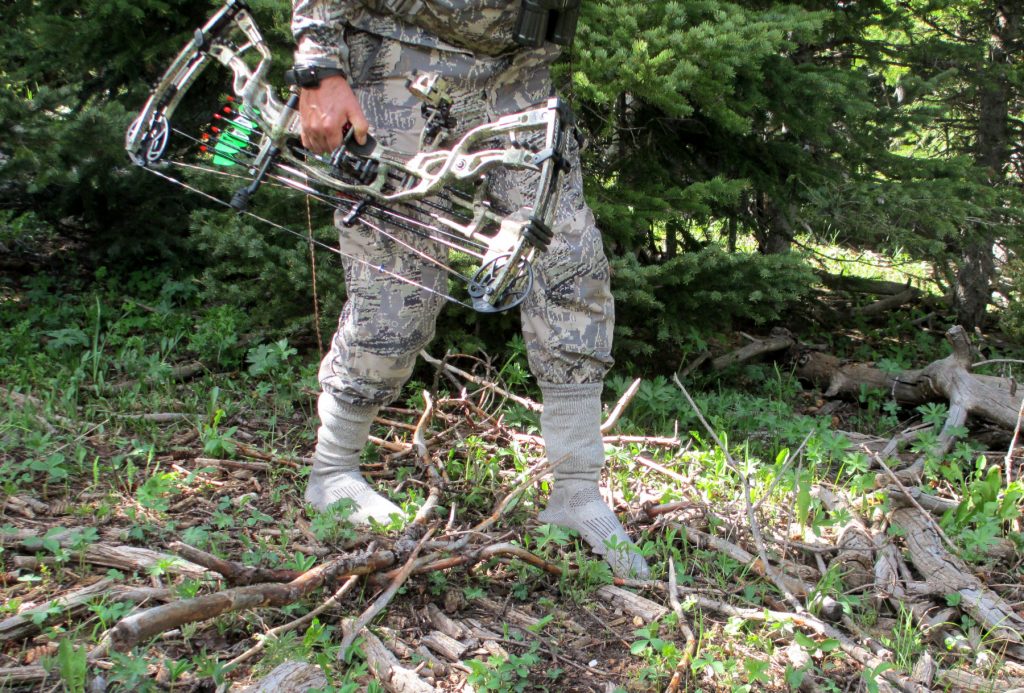
The one benefit stalking has over calling during the rut is that you are able to get close to the elk, but never alert them to your presence or location. With calling, once you bugle or cow call to the elk, they have a very keen ability to pinpoint exactly where you are. When they come in to the calls, they are looking for you. That is why having a caller back behind the shooter is so important. When you are stalking an elk though, the elk is unaware of your presence, and not as likely to be on guard or actively looking for you.
I mentioned shadowing, and I want to explain what I’m referring to. The only real difference between stalking and shadowing is that with shadowing you follow the elk and wait for the bull to come through a shooting lane, while stalking is simply sneaking in on a stationary elk and getting close enough for a shot. If the elk are on the move, you shadow. If the elk are stationary, you stalk.
As hard as it is for me to do, when elk aren’t responding to calls – or even if they are responding but won’t come in – sometimes the most effective thing to do is put the calls away. During the rut, wise old bulls will sometimes be less responsive to calls, especially if they have received previous pressure. Also, later in the season – after the rut – bulls are sometimes still vocal, but not as likely to come in to the calls, so stalking becomes a very viable option.
Stalking and shadowing require considerable amounts of patience. There are times when a stalk will require you to remain motionless for hours on end. This can be especially trying if you are stuck out on a hot, open hillside with a bull bedded down just 60 yards away. You are too close to make any errant noise or movement, and the sun can be overbearing. The opposite extreme is also a challenge…cold, blowing winds in the late seasons can make it difficult to sit tight for several hours. Unlike calling, where you can often get aggressive and create an opportunity, with stalking, it’s important to take your time and wait for an opportunity.
Similar to any elk hunting tactic, with stalking, you must first find the elk, then employ your tactic. During the rut, you can use a location bugle to get a response from a bull, especially if you are hunting in timber or thick brush. Once you pinpoint the bull’s location, you move in silently. If calls aren’t a part of your repertoire, you will be limited primarily to spotting. Good optics become much more critical as you scan far-away hillsides and bedding areas for elk. Additionally, if you are hunting the rut, you can often just listen for a bugling bull and then move in for a closer look and a stalk.
AVOID DETECTION
For either tactic, the first part of your approach isn’t too difficult. In thick timber/brush, the elk will be relying primarily on their senses of hearing and smell to detect danger. As long as you stay fairly quiet and keep the wind in your favor, it isn’t too difficult to get inside 300 yards. Out in more open country, elk will also be relying on their vision, primarily picking up on “side-to-side” movements. As long as you use the available cover and move towards the elk when they have their heads down, you should be able to get inside 300-400 yards unnoticed. It is the final stalk – closing the distance from 300 yards to inside bow range – that becomes the challenge.
Once you are inside 300 yards, you need to be intimately aware of the elk’s senses: sight, sound, and smell. I prefer to get on the same general level as the elk, which helps regulate thermals and minimize the chances of the elk smelling you. Since the elk have no idea you are there, you can take your time and make sure the wind is right before making your approach. By making extra efforts to get the wind in my favor, I can honestly say that most of the stalks I have blown have been due to moving at the wrong time (being seen) or making noise (breaking a branch, scuffing feet on a rock, etc.).
As mentioned previously, elk use their sense of vision more as a backup sense. While they are always paying attention to their nose and their hearing, they don’t always focus a lot of time on scanning an area visually, unless they hear something first. Always make sure you limit your movements, and never move if an elk’s head is exposed to you. If you can see their head, they can likely see your movement.
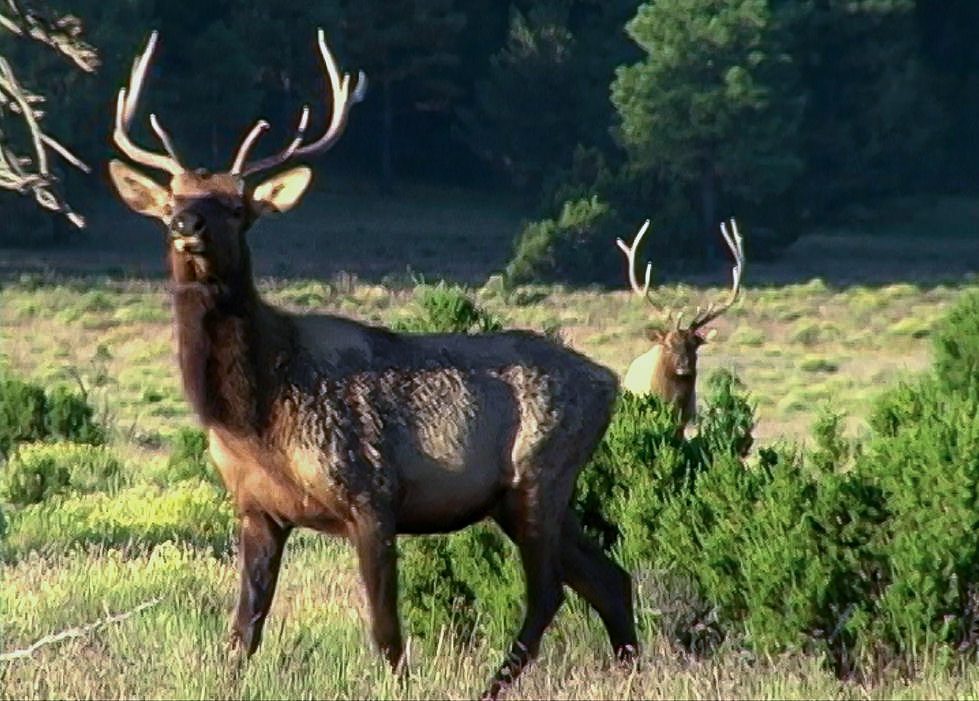
Time your movements when their heads are not exposed – move when they move, when they drop their head to eat or drink, etc. Try to keep your movements slow and move straight at the elk. If you try moving laterally (side to side) at these close distances, you are more likely to get picked off. Be constantly watching the elk and planning your movements based upon their actions. Glance down at your feet periodically to make sure you don’t rustle brush or break branches, but don’t focus your attention there. And if you happen to draw their attention toward you, freeze. Any movement once they key in on your presence is a sure way to send them running.
AMBUSH – TREESTANDS & GROUND BLINDS
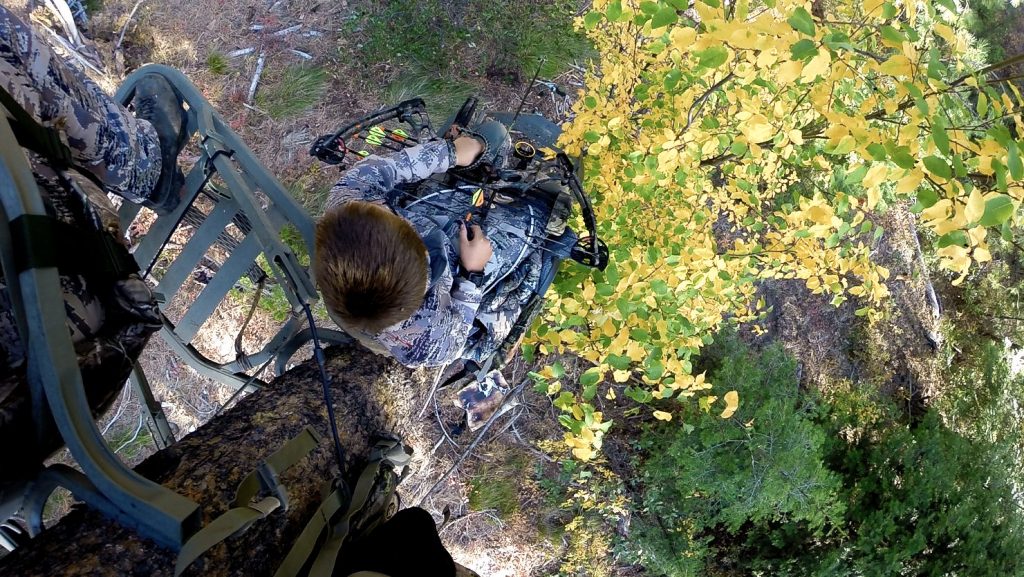
Another tactic that requires a great deal of patience, but that can be effective for hunting elk without calls, is the use of a treestand or groundblind. There are some advantages and disadvantages to each method, but for the most part, they accomplish the same goal – concealing you from elk that are frequenting the area in a way that provides you with an opportunity for a shot. While it is possible to use calls from a treestand or groundblind, I’ll focus this strategy on setting them up in a way that doesn’t utilize calling. If you want to add calling to your treestand or groundblind setup, it is definitely an option.
The advantage of a treestand versus a groundblind is visibility. You can usually see better from an elevated platform than you can from ground level. And while it is possible to position a treestand in a manner that will minimize the effects of the thermals, there are definite scent advantages to using a groundblind. It is often easier to contain your scent inside a groundblind and keep errant thermals from carrying your scent toward nearby elk.
Other advantages of a groundblind are movement and mobility. Because you are mostly concealed in a ground blind, you can get away with drawing a bow and other movements you have to be more conscientious of in a treestand. A groundblind can also be more readily picked up and moved a couple hundred yards if necessary, while a treestand can be somewhat limited on the areas it can be employed.
WHERE TO SET UP
Outside the discussion of which method you prefer to use, both tactics are quite similar. Your goal is to set up in an area where you are confident the elk will visit, and be set up close enough to get a shot. There are three main areas to consider setting up a treestand or groundblind: over waterholes/wallows, along a well-used game trail, or over bait.
Water & Wallows
Elk need water, and they need it pretty much every day – sometimes multiple times per day. If you can find a good, consistent source of water, that can be a great place to set up. In areas where water is in abundance, placing a treestand or blind over water can be less effective as the elk may not be using that particular source on a consistent basis. However, in areas where water sources are limited, these locations can provide a lot of action.
Another area to consider setting up that is similar to water is over a wallow. Bull elk will often wallow during the rut to help control their body temperatures amidst warm weather and the tiring rut activity. Bulls will often utilize a spring or water hole, or use their antlers to tear up moist soil to create a cool place to lay down or roll around.
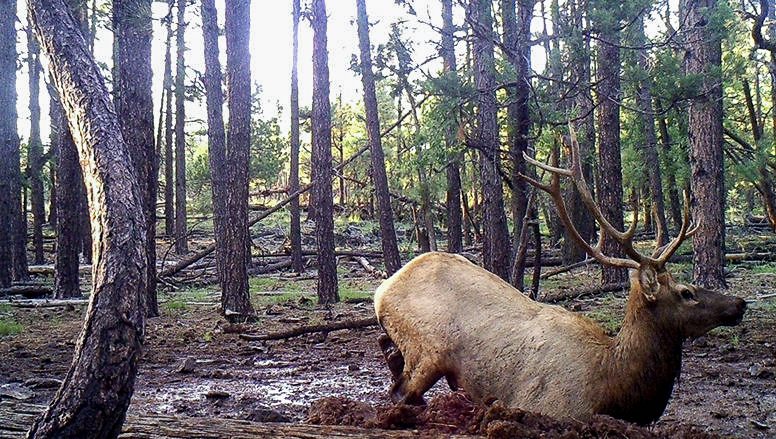
Wallows can be effective mid-morning or throughout the afternoon as the midday heat drives the bulls to find a place to cool off.
Game Trails
Another common area to consider setting up a treestand or ground blind is along a well-used game trail. Elk travel, sometimes several miles per day, and knowing their travel habits can be a very effective way to hunt them. Areas where several trails intersect, or natural funnels like saddles in a ridge can be great places to set up to ambush an elk.
Be sure to consider what the thermals are going to be doing during the time of the day that you would expect to see the most movement. If you set up above a game trail and you expect the elk to be coming by as they move from their feeding areas to the their bedding areas, you might have some very unproductive sits.
Baits & Attractants
The last place I’ll mention for the placement of a treestand or groundblind is over bait. There are ethical and legal considerations in regards to the use of bait, but if it is legal and you are comfortable using it, bait can be a great way to attract elk to an area. Many states allow the use of minerals or salt to attract big game, and elk are especially susceptible to these attractants. Finding an area that is in close proximity to water and intersecting game trails or saddles can be a great place to place salt or other attractants.
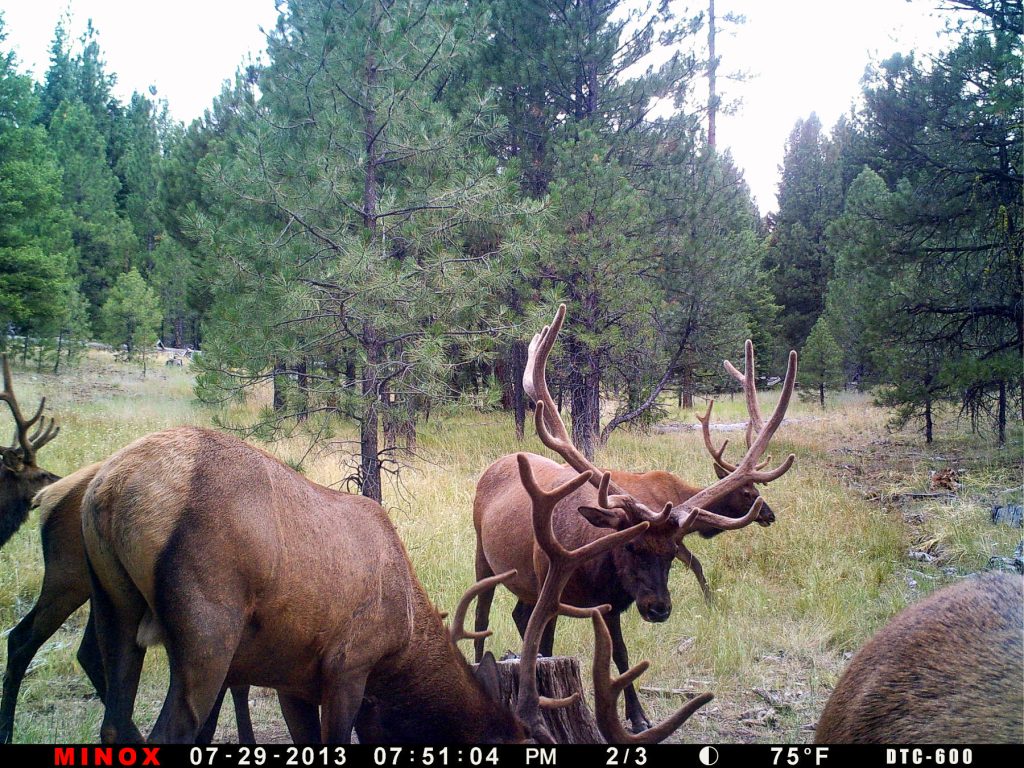
Regardless of where you choose to place a treestand or groundblind, once you’ve decided on a location, game cameras can verify several key pieces of information. Primarily, you can see when elk are passing by these locations, how many elk are in the area, and the size of the elk in the area. I like to set out 4-6 trail cameras in different areas to get a good idea of what animals are in the area. Shortly before season, I check the cameras and then place my treestand or groundblind in the best area or areas.
Unfortunately, elk aren’t always consistent in the areas they visit, and it may be several days in between when they frequent certain areas. It will often require a great deal of patience as you sit and wait for elk to show up. Putting yourself in areas that hold higher densities of elk will provide more action. However, if you are particular about hunting a specific bull, it can be a test of patience for sure.
When hunting in this manner, it’s important to consider the thermals, especially during the times of the day when you are seeing the most activity. Be sure to set up on the downwind side of where the elk are most likely to approach, and recognize when the thermals shift. It may be necessary to only sit these locations during certain times of the day when the thermals are cooperating.
Set up in a way that doesn’t draw attention (i.e., don’t set a ground blind out in the middle of an open meadow and expect the elk to readily approach it). Use natural surroundings to camoflague your setup and conceal your treestand or groundblind. Lastly, limit your movements and noise, both in getting into your setup and while you are there.
Hunting from a treestand or groundblind is not usually as exciting as calling or stalking, but it can be every bit as effective. It takes a lot of homework, but once you have the elk patterned and your ambush location readied, it is often just a matter of time.
WHAT KIND OF TREESTAND?
There are literally 100’s of different brands and styles of treestands on the market today. The style of stand you purchase will depend upon your hunting style and the area you are hunting. To help you decide which style might work best for you, I’ll discuss the pros and cons of the three main styles of treestands: Hang-on stands, Climbing stands, and Ladder stands.
Hang-on Treestands
If you are looking for a spot to hang a treestand and leave for the entire season, I would recommend using a hang-on treestand. Hang-on stands are sometimes a bit more difficult to set up, but allow for more flexibility as you look for places to set them. You can literally climb up in the branches of a tree and set a hang-on stand, leaving you with more concealment and a wider selection of treestand placements.
Hang-on stands will require the use of a climbing ladder, climbing sticks, screw-in steps, or natural limbs to access the stand. In an area where there are lots of large, mature trees with thick branches and limbs, hang-on stands are an excellent option. They are also the lower-priced option of the three, and generally weigh the least (10-20 pounds).
Climbing Treestands
A climbing stand can be a great option for an elk hunter as they are designed to be completely portable, and can usually be easily carried in and out of the woods with backpack straps (often included with the stand).
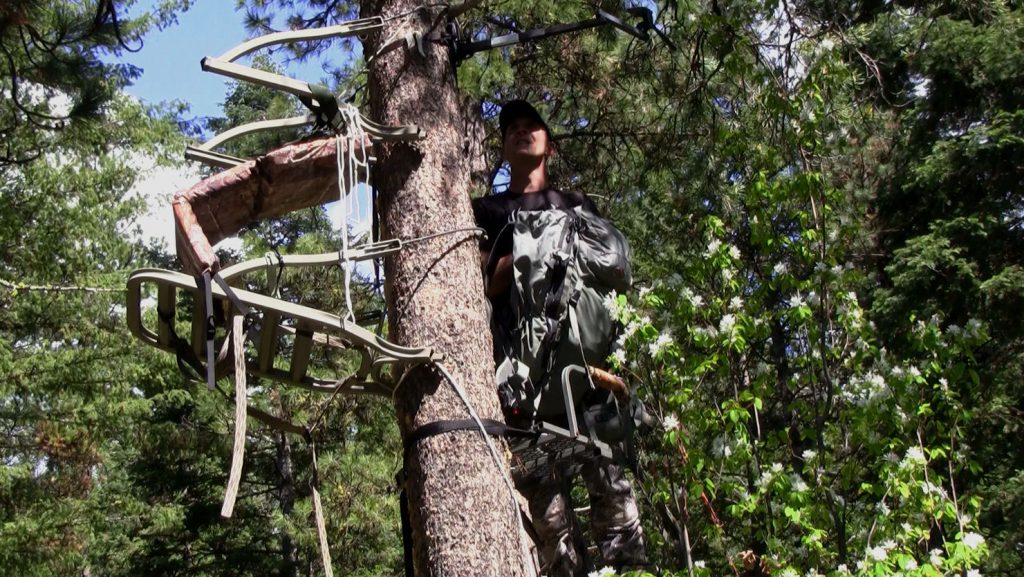
Climbing stands allow you to stay mobile and move your stand location frequently. They also allow for immediate, simple adjustment for how high you setup in the tree or what direction you are facing. Another benefit to climbing stands is that they don’t require any kind of ladders or steps to access. You simply attach it to the tree, and use the stand to ascend up into the tree.
The downside to climbing stands is that the tree needs to be reasonably straight and free of branches, and you will be limited to the size of trees you can attach to. However, if you hunt an area that requires you to remove the stand when not in use (thieves, vandals, laws, etc.) or if you like to move around from area to area, climbing stands are a great choice. I personally use climbing stands, and for the way I use a treestand (not frequently, staying light and fast), I feel they are the best choice for me. Depending on the material and construction, climber stands usually don’t weigh much more than a hang-on stand (12-30 pounds).
Ladder Stands
Although ladder stands are heavy and much harder to move around, they definitely have a place in the pursuit of elk. If you are planning to hunt in the same area for an extended period of time, they are much more comfortable and stable. Additionally, if you are looking for an option for placing a young hunter or new hunter, or if you are afraid of heights, ladder stands are easier to climb into. Plus, there are models available that seat two hunters, which can also be useful for hunting with youth or new hunters.
These types of stands typically include the ladder, platform, and seat in one integrated package. The ladder portion is usually modular, and you can add more ladder sections to increase the height of the stand. Once the stands are set in place, they allow you to climb up and down quietly and provide a great deal of safety and security. The down side is the weight and size, as well as the limit on height and the ability to conceal them.
NON-CALLING OPTIONS FOR RIFLE HUNTERS
The tactics of stalking and shadowing a herd are mostly employed by bowhunters. If you are a rifle hunter, you usually end up with a shot long before you have to worry about going into full stealth mode. There are definitely pieces of those tactics that can come in handy, but for the most part, stalking is an archery elk hunting strategy. When it comes to treestands and ground blinds, they too help a hunter get intimately close to the elk. And while they can certainly be used by a rifle hunter, again, they are primarily used by archers.
When it comes to rifle hunting, there are two primary strategies that can be effective for hunting elk outside the rut: Posting Up/Glassing (static) and Still Hunting (dynamic).
POSTING UP
Posting up is similar to hunting from a treestand or a groundblind, except you don’t use a treestand or a groundblind. Instead, you simply “set up” where you have great visibility of areas where an elk is likely to appear. Then, you let your optics do the work.
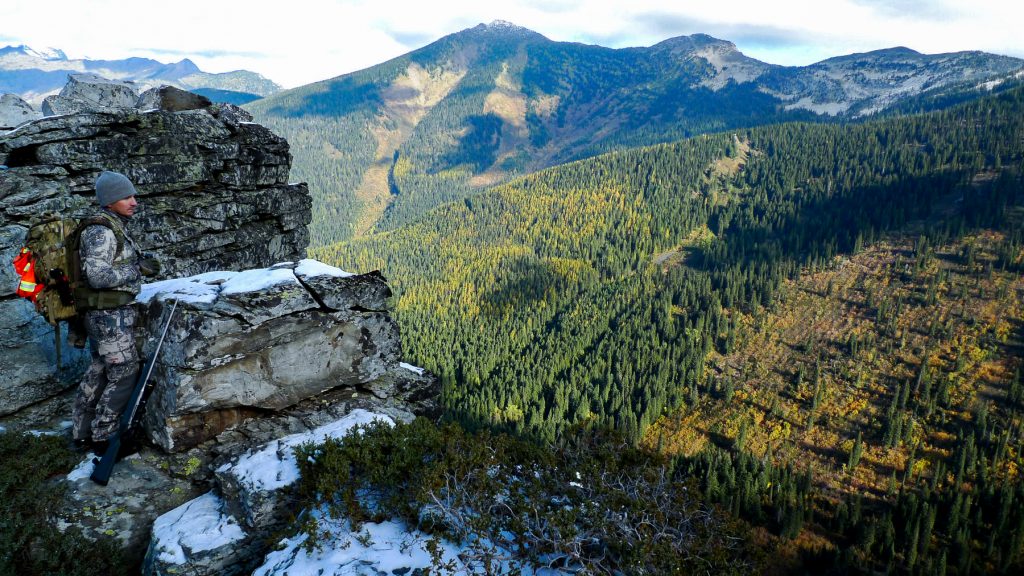
Areas that are effective for glassing elk include open hillsides where they might be found feeding, or waterholes where they would be likely to come in for a drink. If you can find a vantage point that allows you to watch multiple areas, it can be very effective for spotting elk. If those areas are within shooting distance of your setup, it makes it really simple. If you need to move in closer for a shot once you’ve spotted an elk, revert back to the information in the stalking section.
When you are setting up to watch a likely area, be sure to pay attention to the wind. If your scent is being pushed toward the area you are watching, it is unlikely the elk will come out there. Elk are able to smell humans from well over half-a-mile away, so be sure you have the wind in your favor before you choose a location to set up. Elk are usually on the move early in the morning, and later in the evening, so these are going to be the best times to devote to sitting and waiting.
In this situation, your movements and noise aren’t as critical, but they are still worth keeping to a minimum. Good optics are critical, and being vigilant in your watch will be important as elk will often move through an area like a ghost. This tactic is especially effective later in the season after the rut, which often means cooler weather. Be sure to dress appropriately for long sits in unpredictable weather.
STILL-HUNTING
Another method that can be effective for rifle elk hunting is still hunting. While the name might convey a more static approach, it is actually a blend of stalking and posting up. You basically walk very slowly through areas that you know hold elk, stopping frequently to listen or glass. Still-hunting requires more attention to your movements and noise, in addition to the continual monitoring of the wind. This can be an effective method for hunting through a bedding area in the middle of the day, while the elk are not moving.
The combination of posting up/glassing in the morning and evening, and still hunting during the middle of the day can be a great way to hunt elk with a rifle. Again, prior scouting and knowledge of areas that hold elk during this time of year will increase your chances of success dramatically. Also, having a good idea of elk movements within that specific area can be key, and allow you to set up in a way that capitalizes on the elk’s movements.
SUMMARY
Regardless of your hunting style, weapon, or season, there are several tactics that can be used to be successful. Just being a good caller isn’t usually enough to be a consistently successful elk hunter. Adding supplemental tactics to your calling can often make a big difference in your ability to call-in elk. And if calls simply aren’t working or aren’t your style, you can still be very effective and consistently successful.
Perhaps the most important thing for every elk hunter to learn is that there is no tactic that is going to be effective every time. Being able to adapt to situations and find alternate methods to be successful will add another dimension to your hunt – and to your success. Even the most successful elk hunters face multiple challenges every season. Being prepared to recognize and overcome these challenges is vital.
Click Here to Continue to the Next Module: Common Elk Hunting Challenges




